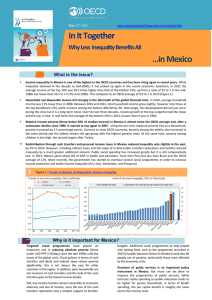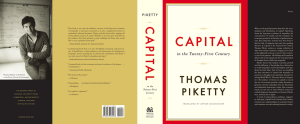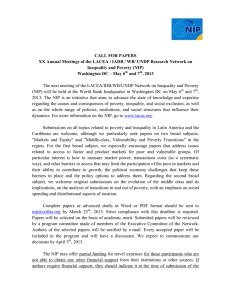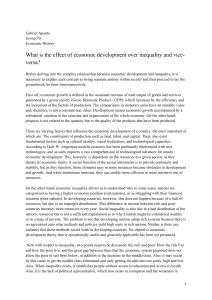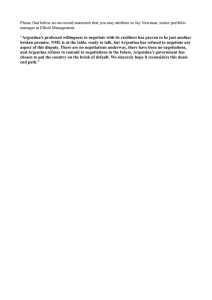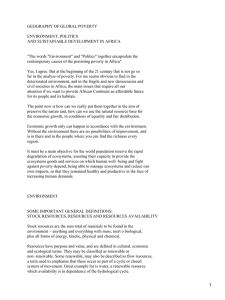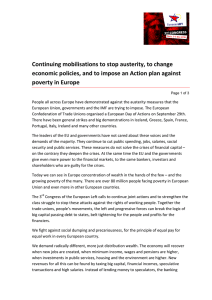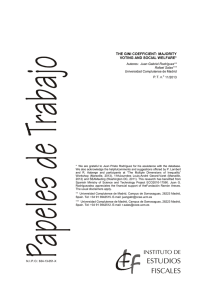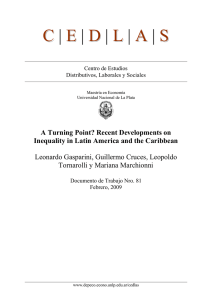Anatomy of Distributive Changes in Argentina.
Anuncio
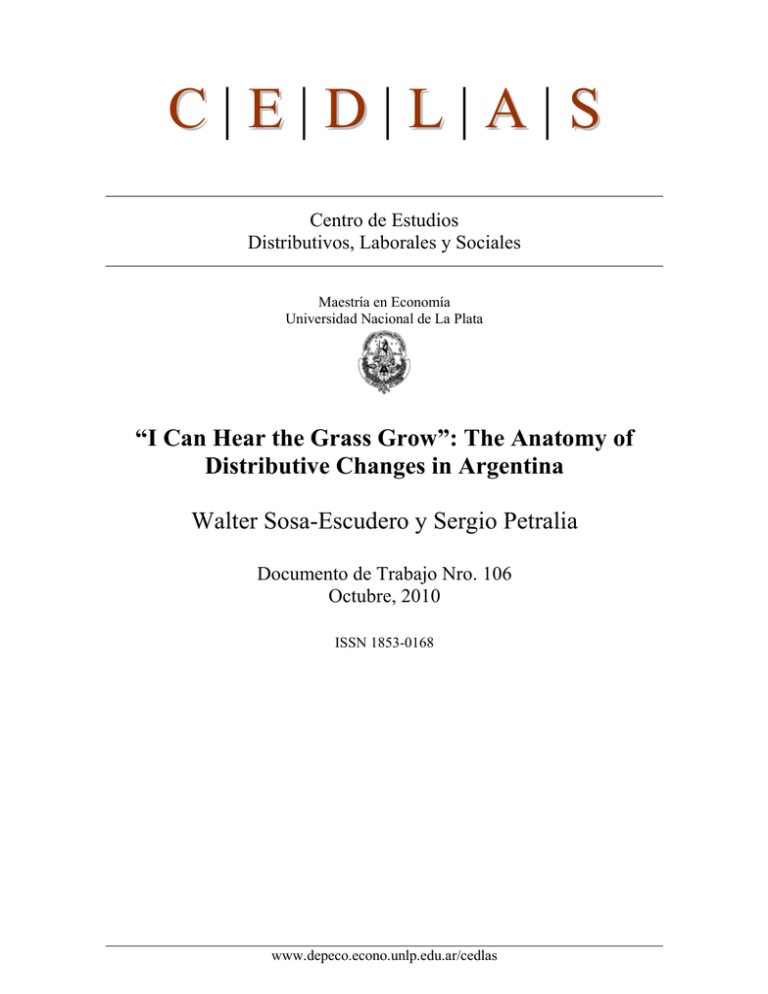
C|E|D|L|A|S Centro de Estudios Distributivos, Laborales y Sociales Maestría en Economía Universidad Nacional de La Plata “I Can Hear the Grass Grow”: The Anatomy of Distributive Changes in Argentina Walter Sosa-Escudero y Sergio Petralia Documento de Trabajo Nro. 106 Octubre, 2010 ISSN 1853-0168 www.depeco.econo.unlp.edu.ar/cedlas “I Can Hear the Grass Grow”: The Anatomy of Distributive Changes in Argentina1 Walter Sosa-Escudero Universidad de San Andrés and CONICET Sergio Petralia Universidad de San Andrés September 2010 Abstract: We present a detailed description of the drastic changes in many aspects of the distribution of income in Argentina, complementing a recent study by Gasparini and Cruces (2009), who focus mostly on inequality. We use modern descriptive tools to provide a complete map of the changes in many aspects of the distribution of income, and stress the fact that other key measures changes dramatically along inequality. In particular, we focus on documenting the changes in inequality along those of poverty and the size of the middle class. JEL Classification: C15, D31, I21, J23, J31 Keywords: inequality, poverty middle class, distribution, non-parametrics, Argentina. 1 Paper prepared for the conference “Comparative Analysis of Growth and Development: Argentina and Brazil”, held at the University of Illinois at Urbana-Champaign, April 2010. We thank Prof. Werner Baer for his encouragement and the invitation to participate. We are much indebted to our colleagues Leonardo Gasparini and Guillermo Cruces for their previous work, their relevant comments, and access to the SEDLAC database. Leopoldo Tornaroli and Mariana Viollaz (from CEDLAS) were very helpful with the EPH survey. As usual, we retain responsibility for any error and omission. Contact information: Walter Sosa-Escudero, Universidad de San Andres, Vito Dumas 284 (B1644BID), Buenos Aires – Argentina. Ph: (54-11) 4725-7053. [email protected]. 1 1. Introduction In most regions and episodes the shape of the income distribution changes slowly, a fact that led Henry Aaron (1978) to state that following them is like “watching the grass grow”. Unlike monetary or financial indicators, poverty or inequality indexes are computed mostly on a yearly basis; moreover, comparative studies have troubles establishing statistical and economic significance of changes in contiguous years (see Sosa Escudero and Gasparini (2001)). In the last thirty years Latin American countries underwent a period of drastic changes, including episodes of marked cyclical macroeconomic performance, as well as profound changes in their economic structures, associated to the globalization/privatization policies of the early nineties. In the case of Argentina, and in contrast to Aaron’s appreciations, the distribution of incomes changed rapidly and significantly during this period, to the point that the title of a song by the cult pop band The Move (“I can hear the grass grow”) seems to provide a more accurate description. Mean income, or related measures of central tendency, like per-capita GDP, sometimes adequately serve the purpose of tracing out the movements in the income distribution, and perform well during episodes where its shape changes slowly. This fact may help justify the scarcity of distributional studies before the nineties in Argentina. The macro-dominated eighties appropriately focused on following GDP, since most changes in the distribution of incomes during that period were macro driven location movements, with subtle changes in other relevant aspects, as documented in Gasparini, Marchionni and Sosa Escudero (2001). The nineties witnessed a massive growth in the number of distributive studies for Argentina, mostly fueled by the fact that inequality and poverty rose persistently since then. The increasing availability of micro data, the sharp decrease in computational costs, and the development of new econometric tools, are all factors that help explain this trend. Nevertheless, the key reason inequality and poverty received so much attention in the last years lies in the dramatic changes experienced by the country, and in the urgency of adopting sound policy measures aimed at alleviating the effects of poverty and inequality. A relevant recent study by Leonardo Gasparini and Guillermo Cruces (2009) documents with detail the literature on inequality in Argentina, identifying historical episodes and highlighting possible explanatory factors, and serves as an important starting point for this paper; as a matter of fact, the quote by Aaron is taken from the Introduction to theirs. 2 In light of the drastic changes in the distribution of income in Argentina in the last thirty years, it is natural to wonder whether these can be appropriately captured by looking at just mean/median incomes and inequality measures. Poverty rates, the size of the middle class, polarization indexes, are examples of concepts that focus on other aspects of the distribution of income, that might have worsened alongside inequality, and must be addressed as well. The main goal of this paper is to complement inequality and mean income analysis by looking at the whole income distribution, with the purpose of providing a more detailed analysis of distributive changes in Argentina that might be overlooked by inequality and income trends. For example, as will be discussed in this article, the Gini coefficients for 1996 and 2006 are very similar, even though they correspond to income distributions of a markedly different shape. Our approach is mostly descriptive. The main goal is to establish some stylized facts on the changes of the whole distribution of income, beyond its center and dispersion. We make no attempts at explaining the causes behind these changes, but try to establish similarities and differences in the evolution of alternative aspects of the income distribution, that should serve as a sound basis for further research aimed at providing causal explorations of these phenomena and, hopefully, at proposing relevant policy measures. The paper is organized as follows. We start with data description and some basic facts, focusing mostly on mean incomes and inequality. In section 3 we step back and adopt a more agnostic non-parametric approach by looking at the whole distribution of incomes, without any attempt of reducing it to summary measures. Section 4 focuses on specific regions of the distribution of income, like the bottom (poverty) or the center (middle class). Section 5 concludes. 2. The basic facts: income and inequality in Argentina Figure 1 sets the starting point for this research. It shows (in different scales) the evolution of inequality as measured by the Gini coefficient, and median income, in the period 1974 to 2006. This figure is eloquent about the impressions advanced in the Introduction: median income wandered cyclically (including periods of severe depressions, more intense than those of recovery), but inequality rose steadily and significantly until 2002, after which, clear signs of recovery are observed. 3 400 0.60 Figure 1: Inequality and Income Gini 0.30 150 0.35 200 Median Income 300 250 0.45 0.40 Gini 0.50 0.55 350 Median Income 1975 1980 1985 1990 1995 2000 2005 Year The notion of income used in the paper is per-capita income as reported to the Encuesta Permanente de Hogares (EPH), which covers mostly labor income and monetary transfers. We have deflacted nominal measures using the official consumer price index. Micro data for the analysis will be the EPH for Greater Buenos Aires (GBA). The focus on a single region may sound severely restrictive at first glance, but, as Gasparini and Cruces (2009) clearly document, including all regions leaves the evolutions of aggregate distributive figures virtually unaltered. On the contrary, the costs of including other regions are prohibitive for the study of evolutions: only GBA is available for a rather long period, a key element in establishing the main point of this article, which requires going back in time as far as possible, using a comparable data set. Household surveys have several limitations to capture the true income distribution, and a myriad of technical decisions are usually taken to deal with some of them, including underreport, the need to find a relevant numeraire to handle household compositions (per capita, by equivalent adults, etc.), the inability to capture alternative sources (like, implicit rents from owned assets), among many others. These problems are important when the goal is to measure the levels of inequality and welfare, but are of a smaller magnitude when the focus is on their evolutions. For the purposes of this paper, we favor a readily reproducible and comparable approach, for which we will stay as close as possible to official, publicly available micro-data. Gasparini, Sosa Escudero and Marchionni (2001) and Gasparini and Cruces (2009) present a very detailed discussion of alternative welfare measures based on different notions of incomes. Gasparini and Gluzman (2009) compare official statistics with privately administered data. Their results support the idea that even though levels may present marked differences; evolutions behave similarly under alternative notions of income and sources. 4 Back to the results in Figure 1, inequality grew steadily since 1974. The Gini measure rose almost monotonically from 0.349 in 1974 to a peak of 0.55 in 2003, after which a period of steady decline started, that puts this figure in 0.48 for 2006. Alternative measures of inequality (Theil, Atkinson, or an entropy-based measure) reveal a similar pattern An alternative way to gauge the severity of the problem is to view the evolution of inequality in Argentina from a cross-sectional, comparative perspective. A Gini coefficient of 0.35 (Argentina in 1974) corresponds to the same figure for the United Kingdom in 2005, and the peak value of 0.55 in 2003 compares to inequality in Brazil or Ecuador, also in 2005. That is, in the period 1974-2003, and in terms of the performance of 2005, Argentina moved from an inequality measure of a developed country like the UK, to that of Brazil and Ecuador, countries with a long history of severe distributive problems. An important issue behind the strong increasing trend in inequality before 2002 is the effect of early information, especially data from the first available points (1974, 1980 and 1986), who have a major effect in determining the, overall, explosive positive trend. As a matter of fact, out of the increase in 0.2 in the Gini coefficient between 1974 and 2003, almost half of this took place along these three periods. This appreciation does not cast doubts on the severity of increasing inequality in Argentina (specially in the nineties), but highlights the limitations of making long run assessments when overall trends are difficult to establish. More concretely, had the analysis been conducted with the likely more reliable and comparable information starting in the late eighties, the perception of the recovery after 2003 suggests a more drastic change in trends than would appear when including distant years like 1974. This fact stresses the need to dig more deeply into the evolution of inequality, in a more historical, long run perspective. Alvaredo (2008) is a clear example of the many difficulties in exploring distributive issue from a historical perspective. The Journal of Iberian and Latin American Economic History (2010) presents a recent collection of papers on the issue. A second look at Figure 1 shows an interesting pattern. It reveals the marked countercyclical behavior of inequality: aggregate improvements in income (as measured by median income) are usually accompanied by improvement (decreases) in inequality. The scope of this paper and the short temporal span of observations prevent us from performing a meticulous time series analysis of this pattern, which would require dealing with the likely non-stationary nature of the series involved. Nevertheless, these preliminary results are strongly suggestive: in spite of the marked increasing trend in inequality, short term movements are strongly associated to the overall performance of the economy. As a matter of fact, the correlation coefficient for the median income and the Gini measure is 0.92. This is particularly relevant for (and 5 very likely driven by) the period after 2002, where the reversion in income trends was accompanied by a sharp decline in inequality. This is a much relevant issue that truly deserves a more detailed econometric, and hopefully causal analysis. To summarize the results of this section, there is clear evidence of a marked increase in inequality in the nineties, robust to alternative ways of measuring it, and of a rapid decline after 2003. The perception of the sudden increase is magnified by its comparison with inequality at the beginning of the analysis, in 1974, where the low numbers observed are comparable to those of a developed country like the UK. The relevance of 1974 as a sound benchmark is debatable and, certainly, requires more analysis. We also highlight the seldom explored cyclical nature of inequality, that beyond its trending behavior shows a strong correlation with the cyclical evolution of median income. This is an important subject that requires more technical scrutiny. 3. A non-parametric perspective of distributive changes in Argentina In 2006, after the rapid recovery after abandoning convertibility, the Argentine economy presented very similar levels of inequality (a Gini index of around 0.47) as in 1994, that is, before the start of the crisis that climaxed in 2002. The anti-cyclical behavior suggested in the previous section, and the observed trend hint towards a stage of recovery in terms of inequality. In light of the drastic changes observed in inequality and median income in this period, it is cautious to wonder whether other aspects of the distribution changed as radically as its dispersion and center, and how this sudden recovery in terms of inequality affected the whole distribution. Non-parametric techniques are powerful tools when the purpose is to reveal the shapes of relevant densities, like that of incomes. Burkhauser et al. (1999) is one of the first studies along these lines. Botargues and Petrecolla (1999) is a very early example for Argentina. We refer to Li and Racine (2007) for a detailed discussion of these methods. Figure 2 shows a three dimensional plot of the evolution of the income densities for the period 1974-2006. The income density for each year is estimated separately using standard non-parametric kernel methods. Bandwidths are chosen using a datadriven algorithm, and results are robust to significant variations in these values. 6 Figure 2: Three Dimensional Plot 0.004 ity D ens 0.002 1980 Inc om Ye ar 0 e 500 2000 There are several aspects highlighted by these estimates. First, inequality increased mostly due to movements of the central part of the densities, to its left, with much larger intensity in the low ranges. As will be discussed in more detail in the next subsection, inequality and poverty moved synchronically in the period under study. This appreciation makes increases in inequality look even more dramatic. The deterioration in inequality is captured by a marked accumulation of values around lower levels of income, that is, a relatively flat density for 1974 contrasts strongly with the highly peaked ones of the late nineties. A relevant comment is that periods of rapid acceleration in prices (for example, the hyperinflationary episode of 1989, or the devaluation in 2002) imply drastic changes in the distribution of incomes with a sudden accumulation in low values, followed by a very rapid recovery. This pattern is highlighted in Figure 3, which 7 presents densities estimated for the period covering the 2002 crisis. These sudden changes (which have a stronger impact on poverty measures) are likely driven by similar movements in the deflactors used to compute real income. Consequently, years corresponding to large variations in price levels introduce significant volatility and may confound the analysis of trends. For example, in our plot in Figure 2, the high peaked density in 2002 looks more like an outlying observation that actually masks (and drives) the rapid recovery in the following year. 0.004 Figure 3: Densities During the Crisis Density 0.000 0.001 0.002 0.003 Year 2002 Year 2001 Year 2003 0 200 400 600 800 Income Regarding our original concern about the need to observe income distributions beyond median income and inequality, Figure 4 compares income densities for 1986 and 2006, which cover a period of drastic changes. The year 1986 provides a more representative starting point, free from the concerns regarding the isolated measures of the 70’s (as discussed in the previous section), right after the recovery of democracy and after the implementation of strong policy measures aimed at controlling inflation (the Plan Austral). The solid vertical line represent the poverty line (almost identical in both periods, in real terms), and median incomes are marked in the horizontal axis. Thin lines correspond to 1986, and thick ones to 2006. Inequality is larger in 2006, but differences are not as dramatic as those implied by the years right after the crisis in 2002. Nevertheless, the shape of the density of incomes is completely different. In 1986 the poverty line lies to the left of the mode whereas in 2006 to its right. The facts that the density shifted to the left, and that the poverty line remained constant imply that 8 poverty in 2006 is not only higher but also much more “stable” than in 1986. Unlike 1986, in 2006 the mode of the whole income density is also the mode of the income of the poor, whereas in 1986 the modal income of the poor is, trivially, the poverty line itself. 0.0025 Figure 4: Comparative Analysis 1986-2006 Year 1986 Year 2006 0.0015 0.0000 0.0005 0.0010 Density 0.0020 Poverty Line | 0 200 | 400 600 800 Income The results of the previous section suggest a period of rapid and significant recovery after 2003. It is interesting to observe whether this recovery implies a return to the situation in the early nineties, right before the rapid deterioration of inequality started. Figure 5 compares 1994 and 2006. These two periods are interesting. The year 1994 marks the start of the process of sustained increases in inequality and poverty, but with very similar values of inequality and median income to those of 2006, the last period under analysis, and well after the decreases in inequality experienced after the crisis of 2002. Even though the centers (median and mean income) and dispersions (inequality) of these densities are almost the same, the underlying densities are different. In the comparison between these two periods, the right tail of the density remained unaltered for both distributions whereas a substantial proportion of the center of 1994 distribution shifted to the left. 9 0.0025 Figure 5: Comparative Analysis 1994-2006 Year 1994 Year 2006 0.0015 0.0000 0.0005 0.0010 Density 0.0020 Poverty Line || 0 200 400 600 800 Income Inequality remained unaltered in these two periods, mainly because most to the changes took place close to the left of the center of the densities. That is, more accumulation in the right tail would drive inequality up, but more concentration close to the median would drive inequality down. In 2006 the poverty line lies clearly to the right of the mode, unlike 1994, where it lies very close to it. Consequently, even though in terms of inequality and median income the argentine economy has given clear signals of recovery, the poor appears as a more homogeneous and stable than in 1994. Finally, even though the estimated densities clearly point towards a much more peaked distribution, with a stronger prevalence of the poor as modal group, the results do not suggest obvious unambiguous clusterings based on income. Visual inspection does not reveal relevant multimodalities that would enable the classification of individuals in markedly different groups, like the extreme poor, the rich, or even the middle class. A more detailed analysis of the possible presence of multimodalities is beyond the scope of this article, but it is an interesting research topic, which requires a more careful treatment in order to deal with the markedly asymmetric nature of the distribution of incomes, and more formal tests of these multimodalities. To summarize, inequality increased considerably but also implied a drastic change in the center and left tail of the distribution of income, leaving the poor as a larger and more cohesive group, that now clearly contains the mode of the distribution. As a matter of fact, even after the drastic decreases in inequality in the last five years, 10 the Argentine distribution of incomes is not returning to the shape it had before the sudden changes implied by the crisis in 2002. 4. The poor and the middle class The previous section suggests that important movements took place at the left of the distribution. Also, the lack of obvious multimodalities make it difficult, if not impossible, to rely on the income distribution itself to identify groups like the poor, the rich, or the middle class. That is, if these groups truly exist, they must be identified exogenously, and we must accept the fact that any disjoint, sharp partition among them should be very sensitive to the choice of the thresholds that define them. 4.1 The poor Consider the case of the poor. If a standard poverty line criterion is adopted to identify them, when income becomes very concentrated close to the poverty line, classifications become erratic, as a substantial number of individuals with incomes marginally above the line are rendered as non-poor, even though in economic terms their income is indistinguishable from that of those marginally below. Naturally, a similar comment holds for the middle class. In periods of sudden changes in nominal and real variables, like in Argentina, this issue affects poverty considerably. Figure 6 shows the evolutions of inequality and poverty, the latter measured by the headcount ratio using official poverty lines. Isolated numbers are dramatic, since the range of variation covers low values in the eighties (below 35%) and figures above 60% during the crisis in 2002. The long swings associated with strong accommodations of relative prices (mentioned in the previous section), are much more marked in the case of poverty than inequality, which is natural since in computing poverty, deflactors play an important role in determining income as well as the poverty line. As a matter of fact, the correlation between poverty rates and median income is negative and high (-0.84), but lower than that of inequality and median income. 11 1.0 Figure 6: Poverty and Inequality 0.55 Gini Coefficient 0.6 0.4 Poverty 0.45 0.2 0.40 0.0 0.30 0.35 Gini Coefficient 0.50 0.8 Poverty 1975 1980 1985 1990 1995 2000 2005 Year An important point stressed in the previous section, is that the income of the poor in 2006 is more concentrated at lower values, hence, increases in the poverty line take place in 2006 along a descending part of the density, far away from the mode, unlike 1994, when the line is very close to the modal value. Figure 7 explores this argument with more detail, for the whole period. The solid thick line represents the modal income, and the thin one the mean income of the poor (with a different scale); we have also added the poverty line with a dashed line. From 1974 to 1986 the mode of the whole distribution lies to the right of the poverty line, hence the latter is (trivially) the mode of the poor. Overall, the pattern is similar to other measures: the mode departs further away (to the left) with respect to the poverty line, with a recovery after 2002. Modes represent points of high concentration of individuals, and these results clearly show that the mode of the poor has moved further to the left of the poverty line in the nineties, but, unlike inequality, the recovery after the crisis is not enough to restore it to its initial position, below the poverty line. This is the sense in which we claim that even after the clear signs of recovery in inequality terms, the poor are left behind as a more coherent group. 12 90 Mode of The Poor Mean Income of The Poor 100 100 Income 150 110 120 200 Figure 7: Analysis of Poverty Mean Income of The Poor 80 50 Poverty Line 1975 1980 1985 1990 1995 2000 2005 Year 4.2 The middle class The problems of identifying the poor are more severe when performing the same task for the middle class. As a matter of fact, it is relevant to remark that middle class studies are almost inexistent compared to those available for poverty and inequality. Some very recent references for Argentina are Callorda and Caruso (2009), Olivieri (2009) and Cruces et al. (2009), the latter including a more detailed discussion of alternative measures of the middle class. As expected, there is not a well established operational definition of the middle class. Without being too specific about details (we refer to Cruces et al. (2009) for a lengthy discussion), alternative measures favor either relative notions (“those between the 0.3 and 0.8 percentiles” as in Barro and Easterley (2001)) or absolute (“those with income between 2 and 10 dollars per day”, as in Banerjee and Duflo (2007)). Birdsall et al. (2002) define the middle class as those with incomes between 0.75 and 1.25 times the median income. Naturally, the Barro-Easterley measure implies a constant size of the middle class (it is always 50%), so to measure its importance, they focus on the mean income of this group. A second problem with this measure is that it ignores the implicit definitions of the poor in terms of poverty lines, that is, and for the case of Argentina, in the last part of the crisis many families would be doubly classified as poor and middle class if a standard poverty line is used to identify the poor, and the Barro-Easterly concept is used to define the middle class. A similar concern affects Birdsall et al.’s measure. Banerjee and Duflo’s approach is compatible with one 13 particular definition of the poor (based on the U$S 2 per day line). Another relevant problem with identifying the sizes of the middle class is related to the well known difficulties household surveys have in capturing rich families. This may distort severely the importance of the middle class as compared to that of those above it, since families in that range are either absent from surveys or appear with grossly underreported incomes. We will consider a fourth simple strategy, which consists in defining the middle class as those above the poverty line and below the 0.9 percentile of income. Though trivial (the size of the middle class is determined by that of the poor, as its mirror image since the “rich” is always 10 percent), this measure is a compromise between an absolute one like in Banerjee and Duflo (but using as lower bound the poverty line), and a relative magnitude on the right tail (like in Barro and Easterley), where there is less agreement about how to separate the rich from the rest, and in a region where missing data and underreport are very likely to occur. Two measures will be computed from our definition: the first one is simply the proportion of individuals in the middle class, which, as mentioned above, is by definition a mirror image of the poor. The second is the ratio of the size of the middle class over that of poor, which measures the relative importance of the middle class as compared to a well defined group in absolute terms, like the poor. Figure 8 presents estimates of the size of the middle class, based on the previous concepts. The thick line represents our proposed “hybrid” criterion, and the thin line represents Banerjee and Duflo’s measure (BD, henceforth). Trivially, the horizontal 0.5 line represent Barro and Easterly’s measure. As expected, differences are relevant, since both measures are based on alternative thresholds. During the nineties, both measures stay surprisingly close to the Barro/Easterley figure. When the crisis starts, our measure drops dramatically, a consequence of the sudden increase in poverty rates. The BD measure stays relatively close, mostly due to the fact that it contains as middle class many individuals rendered as poor by the standard poverty line criterion. 14 0.9 Figure 8: Size of the Middle Class 0.7 0.6 0.5 0.4 0.2 0.3 Percentage of the Population 0.8 Hybrid BD BE 1975 1980 1985 1990 1995 2000 2005 Year Figure 9 offers an alternative perspective. Based on our proposed hybrid measure, we computed the ratio of the sizes of the middle class and the poor. This measure has a clear negative trend, more compatible with the perceive notion of deterioration of the middle class. Beyond the trending behavior described above, there is one episode where the size of the poor exceeds that of the middle class, corresponding, precisely, to the drastic crisis of 2002. In spite of the comments of the previous section in terms of the volatility of poverty measures in such periods, it is important to highlight this issue: critical episodes put the poor as the largest group in the society, and in the center of the action of distributive dynamics. 8 6 4 2 0 Middle Class / The Poor 10 12 Figure 9: Middle Class and the Poor 1975 1980 1985 1990 1995 2000 2005 Year 15 Regarding the income of the middle class, Figure 10 presents the measures proposed by BE, BD, and ours. The overall trends look similar as those for the sizes, but an important difference arises. When the focus is on the mean income of the middle class, the nineties are a rather stable (though erratic) period. This may be due to a composition effect. The BD measure treats as middle class many individuals considered as poor by standard poverty analysis (and hence, out of the middle class in our hybrid definition), hence for the middle class as defined by BE, the increases in median income of the nineties are mixed with the increases in poverty (and inequality) in the same period, resulting in minor variations in the average income of the middle class as defined by BE, which includes widely heterogeneous individuals. 450 Figure 10: Income of the Middle Class 300 250 150 200 Mean Income 350 400 Hybrid BD BE 1975 1980 1985 1990 1995 2000 2005 Year The results of this section suggest that the middle class is a very elusive concept if its identification is based solely in income. When defined endogenously, in relative terms, and jointly with the poor, the middle class is subject to the wide movements of the poor, and as a consequence, it decreased considerably in the nineties, but recovered quickly after 2003. On the other hand, when defined exogenously and in absolute terms, like in Barro and Easterly, it is a much more stable unit, except for periods where median income decreases sharply, as in the crisis. Many social actors perceive that the nineties had a strong negative effect on the middle class. According to our results this perception is compatible with a relative notion of middle class (like our hybrid measure), mostly reflecting the increasing 16 importance of the poor. In connection with the results of the previous sections, the fact that in the nineties modes occur outside most characterizations of the middle class in Argentina, imply that the center of the distribution of those in the middle class is not representative of them, that is, and unlike the poor, the distribution of incomes within the middle class became flatter. Either the existence of the middle class became unrepresentative, as compared to that of the poor, or its identification should rely on alternative welfare components, that cannot be appropriately represented by income. 5. Concluding remarks In the last thirty years Argentina experienced drastic changes in its income distribution, mostly characterized by a long period of increased inequality and poverty, and a stage of recovery after 2003. Inequality and poverty figures reached dramatic levels, which justifies placing these distributive issues right at the center of the academic and policy agenda of the country. The results of this paper show that it is important to trace out the whole income distribution along that of inequality, especially in its lower parts. Increases in inequality are mostly driven by deterioration in the lower levels of the distribution of income. Besides increasing inequality, the nineties left the poor as a larger and more homogeneous entity. If modal income is taken as representative of a distribution, in the eighties it represented the division between the poor and the non-poor, while after the crisis (and even after the recovery took place), it now represents the poor. The middle class is an elusive group, that if defined residually from the poor, it evolves as its mirror image. The fact that after the nineties, the mode of the income distribution lies within the range of the poor implies that the distribution of income inside the middle class is more homogeneous, and hence its median income less representative of its individuals, that is, the average income of the middle class represents a center of a rather flat distribution, making it a less coherent group. A dramatic result is its relative performance in critical periods. The results show that in the last thirty years, and coinciding with the crises, the middle class lost its predominance over the poor. Other relevant results of this paper are the strong correlation of median incomes and inequality, or poverty: crises affect inequality and poverty negatively, but recoveries quickly restore levels to less dramatic ones. We also highlight the fact that 17 critical episodes introduce substantial instabilities in distributive figures, so those years should be handled with care. Many aspects of this study deserve further analysis. The cyclical behavior of inequality and income (a long standing issue in the development literature that dates back to the “Kuznets Hypothesis”) deserves more careful study. Time series analysis seems prohibitive due to the limited availability of long series of distributive measures, but dynamic panel strategies may compensate the short temporal dimension with cross-sectional variability. A more focused exploration on the performance of the rich is still a difficult but much relevant subject. Also, this study focuses strictly on monetary income. Recent trends in the literature (see the collection of papers In Kakwani and Silber (2008)) emphasize the multidimensional nature of welfare, suggesting that other dimensions should be studied alongside income in order to assess its evolution. In particular, the results of this paper suggest that income per-se has serious troubles in producing well separated groups like the poor or the middle class, which speaks about the relevance of adding other dimensions of welfare that may help finding and defining such partitions. Finally, and obviously, causal studies of the determinants of these changes are as urgent as the need to design and agree on the implementation of sound policy measures, aimed at alleviating the negative effects of the drastic distributive changes experienced by Argentina in its recent history. The results of this paper, hopefully, should help establishing some empirical regularities that deserve deeper investigation. 6. References Aaron, H., 1978, Politics and the Professors, Brookings Institution, Washington DC. Alvaredo, F., 2008, The rich in Argentina over the twentieth century: From the Conservative Republic to the Peronist experience and beyond 1932-2004, PSE Working Paper. Barro, R., 1999, Determinants of Democracy, Journal of Political Economy, vol. 107(S6), pages S158-29. Banerjee, A. and Duflo, E., 2007, What is middle class about the middle classes around the world?, MIT Department of Economics Working Paper No. 07-29. Birdsall, N., Graham C. and Pettinato S., 2000, Stuck in the Tunnel: Is globalization muddling the middle class?” Brookings Institution, Center on Social and Economic Dynamics WP No. 14. 18 Botargues, P. and Petrecolla, D., 1999, Estimaciones paramétricas y no paramétricas de la distribución del ingreso de los ocupados del GBA, Argentina 1992-1997, Económica, 1, Jan-Jul. Burkhauser, R., Cutts, A., Crews, D. y Jenkins, S., 1999, Testing the significance of income distribution changes over the 1980s business cycle: a cross-national comparison, Journal of Applied Econometrics, 14: 253-272. Callorda, F. and Caruso, G., 2009, Does the middle-class really exist?: A ClusterAnalysis Approach, mimeo, Universidad de San Andres. Cruces, G., Lopez-Calva, L. and Battiston, D., 2010, Down and Out or Up and In? In Search of Latin America’s Elusive Middle Class, UNDP / Research for Public Policy Inclusive Development, Working Paper, ID-03-2010 Easterly, W., 2001, The Middle Class Consensus and Economic Development, Journal of Economic Growth, vol. 6(4), pages 317-35, December. Gasparini, L. and Cruces, G., 2009. Desigualdad en argentina: una revisión de la evidencia empírica, Desarrollo Economico, 1 Gasparini, L. and Gluzman, P., 2009, Estimating Income Poverty and Inequality from the Gallup World Poll: The Case of Latin America and the Caribbean, CEDLAS Working Paper 83. Gasparini, L., Marchionni, M., and Sosa Escudero, W., 2001, La Distribución del Ingreso en la Argentina, Ed. Triunfar, Buenos Aires. Kakwani, N and Silber, J, 2008, Quantitative Approaches to Multidimensional Poverty Measurement, Palgrave Macmillan, New York. Li, Q and Racine, J., 2006, Nonparametric Econometrics: Theory and Practice, Princeton University Press, Princeton. Olivieri, S., 2008, Debilitamiento de la Clase Media: Gran Buenos Aires 1986-2004, unpublished MSc. Thesis, Facultad de Ciencias Económicas, UNLP. Sosa Escudero, W. and Gasparini, L., 2000, A note on the statistical significance of changes in inequality, Economica, 1, 111-122. 19 Table: Basic Measures for Argentina Year Gini Atkinson (2) Theil (0.5) Entropy (0.5) Mean Income Median Income 90/10 Quantil 50/10 Quantil 90 Quantil 10 Quantil Poverty (Survey) Middle Class (Hybrid) Middle Class (BD) 1974 0.350 0.414 0.215 0.209 475 392 4.865 2.243 849 175 0.071 0.826 0.250 1980 0.409 0.656 0.298 0.282 450 340 7.329 2.800 890 121 0.152 0.748 0.332 1986 0.433 0.493 0.332 0.322 405 305 7.619 2.857 812 107 0.215 0.684 0.403 1988 0.467 0.575 0.399 0.375 297 206 9.800 3.311 609 62 0.446 0.454 0.541 1991 0.474 0.530 0.396 0.400 297 197 8.316 2.789 589 71 0.371 0.528 0.581 1992 0.453 0.528 0.363 0.351 337 236 7.857 2.673 695 88 0.284 0.615 0.516 1993 0.451 0.548 0.368 0.350 359 252 8.583 2.991 724 84 0.250 0.650 0.465 1994 0.464 0.526 0.380 0.374 360 245 8.667 2.918 727 84 0.261 0.638 0.494 1995 0.485 0.566 0.420 0.406 333 219 9.750 3.000 712 73 0.341 0.558 0.528 1996 0.488 0.610 0.432 0.413 326 218 9.621 3.097 678 70 0.366 0.533 0.532 1997 0.484 0.590 0.427 0.403 350 228 10.780 3.234 761 71 0.318 0.582 0.492 1998 0.505 0.625 0.471 0.445 359 219 11.470 3.267 769 67 0.344 0.556 0.496 1999 0.496 0.614 0.451 0.425 339 219 11.111 3.333 731 66 0.361 0.539 0.513 2000 0.507 0.679 0.481 0.444 337 215 12.382 3.575 746 60 0.367 0.533 0.509 2001 0.532 0.697 0.541 0.493 312 186 14.583 3.889 698 48 0.432 0.468 0.507 2002 0.540 0.665 0.549 0.512 213 127 15.333 4.195 464 30 0.639 0.260 0.557 2003 0.551 0.681 0.571 0.570 295 166 12.740 3.619 583 46 0.487 0.413 0.544 2004 0.504 0.625 0.472 0.446 280 180 11.845 3.544 600 51 0.441 0.459 0.553 2005 0.500 0.606 0.459 0.442 319 206 10.915 3.394 662 61 0.372 0.527 0.531 2006 0.484 0.617 0.437 0.405 360 242 10.327 3.309 756 73 0.320 0.580 0.465 20 21
